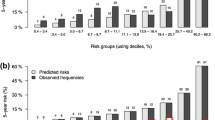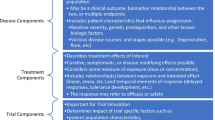Abstract
In model-based analysis for comparative evaluation of strategies for disease treatment and management, the model of the disease is arguably the most critical element. A fundamental challenge in identifying model parameters arises from the limitations of available data, which challenges the ability to uniquely link model parameters to calibration targets. Consequently, the calibration of disease models leads to the discovery of multiple models that are similarly consistent with available data. This phenomenon is known as calibration uncertainty and its effect is transferred to the results of the analysis. Insufficient examination of the breadth of potential model parameters can create a false sense of confidence in the model recommendation, and ultimately cast doubt on the value of the analysis. This paper introduces a systematic approach to the examination of calibration uncertainty and its impact. We begin with a model of the calibration process as a constrained optimization problem and introduce the notion of plausible models which define the uncertainty region for model parameters. We illustrate the approach using a fictitious disease, and explore various methods for interpreting the outputs obtained.





Similar content being viewed by others
References
Berry BYS, Levinsohn J, Pakes A (1995) Automobile prices in market equilibrium. Econometrica 63(4):841–890
Briggs AH, Weinstein MC, Fenwick EA, Karnon J, Sculpher MJ, Paltiel AD (2012) Model parameter estimation and uncertainty analysis: a report of the ISPOR-SMDM Modeling Good Research Practices Task Force Working Group-6. Med Decis Making 32(5):722–732
Brown PO, Palmer C (2009) The preclinical natural history of serous ovarian cancer: defining the target for early detection. PLoS Med 6(7):1–14
Campos NG, Burger EA, Sy S, Sharma M, Schiffman M, Rodriguez AC, Hildesheim A, Herrero R, Kim JJ (2014) An updated natural history model of cervical cancer: derivation of model parameters. Am J Epidemiol 180(5):545–555
Chen Q, Ayer T, Chhatwal J (2017) Sensitivity analysis in sequential decision models: a probabilistic approach. Med Decis Making 37(2):243–252
Chia YL, Salzman P, Plevritis SK, Glynn PW (2004) Simulation-based parameter estimation for complex models: a breast cancer natural history modelling illustration. Stat Methods Med Res 13(6):507–524
Cramer RD, Patterson DE, Bunce JD (1988) Comparative molecular field analysis (CoMFA). I. Effect of shape on binding of steroids to carrier proteins. J Am Chem Soc 110(18):5959–5967
Dentcheva D, Ruszczynski A (2003) Optimization with stochastic dominance constraints. SIAM J Optim 14(2):548–566
Dentcheva D, Ruszczynski A (2004) Semi-infinite probabilistic optimization: first order stochastic dominance constraints. Manage Sci 53(5–6):583–601
Draisma G, Boer R, Otto SJ, van der Cruijsen IW, Damhuis RA, Schroder FH, de Koning HJ (2003) Lead times and overdetection due to prostate-specific antigen screening: estimates from the European Randomized Study of Screening for Prostate Cancer. J Natl Cancer Inst 95(12):868–878
Duan Q, Gupta V (1992) Effective and efficient global optimization for conceptual rainfall–runoff models. Water Resour Res 28(4):1015–1031
Enns E, Cipirano LE, Simons CT, Kong CY (2015) Identifying best-fitting inputs in health-economic model calibration: a Pareto frontier approach. Med Decis Making 35(2):170–182
Frazier LA, Colditz GA, Fuchs CS, Kuntz KM (2000) Cost-effectiveness of screening for colorectal cancer in the general population. JAMA 284(15):1954–1961
Goldhaber-Fiebert JD, Brandeau ML (2015) Modeling and calibration for exposure to time-varying, modifiable risk factors: the example of smoking behavior in India. Med Decis Making 35(2):196–210
Goldhaber-Fiebert JD, Stout NK, Ortendahl J, Kuntz KM, Goldie SJ, Salomon JA (2007) Modeling human papillomavirus and cervical cancer in the United States for analyses of screening and vaccination. Popul Health Metr 5:11
Grover SA, Coupal L, Zowall H, Rajan R, Trachtenberg J, Elhilali M, Chetner M, Goldenberg L (2000) The clinical burden of prostate cancer in Canada: forecasts from the Montreal Prostate Cancer Model. Can Med Assoc J 162(7):977–983
Hadar J, Russell WR (1969) Rules for ordering uncertain prospects. Am Econ Rev 59(1):25–34
Havrilesky LJ, Sanders GD, Kulasingam S, Myers ER (2008) Reducing ovarian cancer mortality through screening: Is it possible, and can we afford it? Gynecol Oncol 111(2):179–187
Hillner BE, Smith TJ (1991) Efficacy and cost effectiveness of adjuvant chemotherapy in women with node-negative breast cancer: a decision-analysis model. N Engl J Med 324(3):160–168
Jit M, Gay N, Soldan K, Choi YH, Edmunds WJ (2010) Estimating progression rates for human papillomavirus infection from epidemiological data. Med Decis Making 30(1):84–98
Katon W, Unützer J, Fan M-Y, Williams JW, Schoenbaum M, Lin EH, Hunkeler EM (2006) Cost-effectiveness and net benefit of enhanced treatment of depression for older adults with diabetes and depression. Diabetes Care 29(2):265–270
Kim JJ, Kuntz KM, Stout NK, Mahmud S, Villa LL, Franco EL, Goldie SJ (2007) Multiparameter calibration of a natural history model of cervical cancer. Am J Epidemiol 166(2):137–150
Kirkpatrick S, Gelatt CD, Vecchi MP (1983) Optimization by simulated annealing. Science 220(4598):671–680
Kohli M, Ferko N, Martin A, Franco E, Jenkins D, Gallivan S, Sherlaw-Johnson C, Drummond M (2007) Estimating the long-term impact of a prophylactic human papillomavirus 16/18 vaccine on the burden of cervical cancer in the UK. Br J Cancer 96(1):143–150
Kuntz KM, Lansdorp-Vogelaar I, Rutter CM, Knudsen AB, van Ballegooijen M, Savarino JE, Feuer EJ, Zauber AG (2011) A systematic comparison of microsimulation models of colorectal cancer: the role of assumptions about adenoma progression. Med Decis Making 31(4):530–539
Loeve F, Boer R, van Oortmarssen GJ, van Ballegooijen M, Habbema JDF (1999) The MISCAN-COLON simulation model for the evaluation of colorectal cancer screening. Comput Biomed Res 32(1):13–33
Lovász L (1999) Hit-and-run mixes fast. Math Program 86(3):443–461
Lovász L, Simonovits M (1990) The mixing rate of markov chains, an isoperimetric inequality, and computing the volume. In: Proceedings [1990] 31st annual symposium on foundations of computer science, vol 1, pp 346–354
Mühlbacher AC, Sadler A (2017) The probabilistic efficiency frontier: a framework for cost-effectiveness analysis in Germany put into practice for hepatitis C treatment options. Value Health 20(2):266–272
Nelder JA, Mead R (1965) A simplex method for function minimization. Comput J 7(4):308–313
Pérez-Ocón R, Ruiz-Castro JE, Gámiz-P’eez ML (1998) A multivariate model to measure the effect of treatments in survival to breast cancer. Biom J 40(6):703–715
Ransohoff DF, Pignone M (2013) Colon cancer screening models: lessons and challenges. Clin Gastroenterol Hepatol 11(9):1167–1168
Robert CP, Casella G (1999) Monte Carlo statistical methods. Springer, New York
Romeijn HE, Smith RL (1994) Simulated annealing for constrained global optimization. J Global Optim 5(2):101–126
Russel LB (2011) Exploring the unknown and the unknowable with simulation models. Med Decis Making 31(4):521–523
Rutter CM, Miglioretti DL, Savarino JE (2009) Bayesian calibration of microsimulation models. J Am Stat Assoc 104(488):1338–1350
Siebert U, Sroczynski G, Hillemanns P, Engel J, Stabenow R, Stegmaier C, Voigt K, Gibis B, Hölzel D, Goldie SJ (2006) The German cervical cancer screening model: development and validation of a decision-analytic model for cervical cancer screening in Germany. Eur J Public Health 16(2):185–192
Simon GE, Katon WJ, Lin EH, Rutter C, Manning WG, Von Korff M, Ciechanowski P, Ludman EJ, Young BA (2007) Cost-effectiveness of systematic depression treatment among people with diabetes mellitus. Arch Gen Psychiatry 64(1):65–72
Skates SJ, Singer DE (1991) Quantifying the potential benefit of CA 125 screening for ovarian cancer. J Clin Epidemiol 44(4):365–380
Smith RL (1984) Efficient Monte Carlo procedures for generating points uniformly distributed over bounded regions. Oper Res 32(6):1296–1308
Stinnett AA, Mullahy J (1998) Net health benefits: a new framework for the analysis of uncertainty in cost-effectiveness analysis. Med Decis Making 18(2 suppl):S68–S80
Stout NK, Knudsen AB, Kong CY, McMahon PM, Gazelle GS (2009) Calibration methods used in cancer simulation models and suggested reporting guidelines. Pharmacoeconomics 27(7):533–545
Taylor DC, Pawar V, Kruzikas DT, Gilmore KE, Pandya A, Iskandar R, Weinstein MC (2011) Calibrating longitudinal models to cross-sectional data: the effect of temporal changes in health practices. Value Health 14(5):700–704
Taylor DC, Pawar V, Kruzikas DT, Gilmore KE, Sanon M, Weinstein MC (2012) Incorporating calibrated model parameters into sensitivity analyses. Pharmacoeconomics 30(2):119–126
Trippoli S (2017) Incremental cost-effectiveness ratio and net monetary benefit: current use in pharmacoeconomics and future perspectives. Eur J Intern Med 43:e36
van Ballegooijen M, Rutter CM, Knudsen AB, Zauber AG, Savarino JE, Lansdorp-Vogelaar I, Boer R, Feuer EJ, Habbema JDF, Kuntz KM (2011) Clarifying differences in natural history between models for screening: the case of colorectal cancer. Med Decis Making 31(4):540–549
van der Steen A, van Rosmalen J, Kroep S, van Hees F, Steyerberg EW, de Koning HJ, van Ballegooijen M, Lansdorp-Vogelaar I (2016) Calibrating parameters for microsimulation disease models: a review and comparison of different goodness-of-fit criteria. Med Decis Making 36(5):652–665
Vanni T, Karnon J, Madan J, White RG, Edmunds WJ, Foss AM, Legood R (2011) Calibrating models in economic evaluation: a seven-step approach. Pharmacoeconomics 29(1):35–49
Walters FH, Parker LR Jr, Morgan SL, Deming SN (1991) Sequential simplex optimization: a technique for improving quality and productivity in research, development, and manufacturing (Chemometrics series). CRC Press, Boca Raton
Weinstein MC, Stason WB (1977) Foundations of cost-effectiveness analysis for health and medical practices. N Engl J Med 296(13):716–721
Weinstein MC, Toy EL, Sandberg EA, Neumann PJ, Evans JS, Kuntz KM, Graham JD, Hammitt JK (2001) Modeling for health care and other policy decisions: uses, roles, and validity. Value Health 4(5):348–361
Zhang Y, Wu H, Denton BT, Wilson JR, Lobo JM (2016) Probabilistic sensitivity analysis on Markov decision processes with uncertain transition probabilities: an application in evaluating treatment decisions for type 2 diabetes. https://btdenton.engin.umich.edu/papers. Accessed Apr 2017
Author information
Authors and Affiliations
Corresponding author
Electronic supplementary material
Below is the link to the electronic supplementary material.
Appendix: The calibration problem
Appendix: The calibration problem
With the assumption that \(\pi _{\text {H}}(0) = 1\) (i.e., \(\pi (0) = [1\ 0\ 0\ \ldots 0]\)), we obtain the calibration targets \(\hat{\tau } = \{ \hat{\pi }_j(a): j \in \{1D, 2D, 3D, DD, DO\}, a \in \mathcal{{A}}\}\, \cup \, \{ \hat{\alpha }_j(a): j \in \{1D, 2D, 3D\}, a \in \mathcal{{A}}\}\) where \(\{ \hat{\pi }_j(a)\}\) and \(\{\hat{\alpha }_j(a)\}\) are calculated via (1) and (2) using \(\mathbb {P}^{\text {true}}\) and \(\pi (0)\), where

Note that from (1) and (2), the modelled outcomes can be represented as:
-
\(\pi _j(a) = [\pi (0) \mathbb {P}^a]_j, j \in \mathcal{{S}}\)
-
\(\alpha _j(a) = \sum \limits _{i \in \{H,1U,2U,3U\}} [\pi (0) \mathbb {P}^{a-1}]_i P_{i,j} , j \in \{1D, 2D, 3D\} \)
where \([\cdot ]_j\) represents the jth element.
By representing \(\mathbb {P}\) as the decision variable, the Calibration Problem for our fictitious disease may be stated as:
Equation (12) states that mortality is independent of awareness of the disease. Equations (13)–(24) indicate that the disease is more likely to remain in the current state than progress to a worse health state or to become detected. Equation (33) indicates that there is a non-zero probability of dying from any state. Equations (34)–(45) represent the biologically plausible ranges for observable transition probabilities. These constraints represent the expert judgment that would likely result from observations of the diseased patients.
Rights and permissions
About this article
Cite this article
Chen, J.V., Higle, J.L. & Hintlian, M. A systematic approach for examining the impact of calibration uncertainty in disease modeling. Comput Manag Sci 15, 541–561 (2018). https://doi.org/10.1007/s10287-018-0329-6
Received:
Accepted:
Published:
Issue Date:
DOI: https://doi.org/10.1007/s10287-018-0329-6




